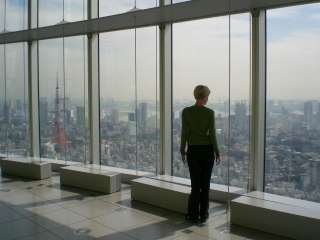 Apparently, it’s quite rare to see Mount Fuji when in Tokyo. Even if one pays the fee to ascend to one of the observation decks in Tokyo, one may not be able to see the mountain unless it’s an exceptionally clear day. When we visited the observation deck of the Mori Art Museum, it was not an exceptionally clear day. Meh, we saw it from the plane anyway.
Apparently, it’s quite rare to see Mount Fuji when in Tokyo. Even if one pays the fee to ascend to one of the observation decks in Tokyo, one may not be able to see the mountain unless it’s an exceptionally clear day. When we visited the observation deck of the Mori Art Museum, it was not an exceptionally clear day. Meh, we saw it from the plane anyway.
 Our second most expensive view (after the New York Bar extravaganza), is the view from our hotel room in Asakusa. If we hadn’t been using credit card points to pay for it, we would not have been able to stay in this hotel. In fact, there is little evidence to suggest we could afford any hotel in Tokyo and would likely have been staying in a dorm room in the cheapest hostel available or a love motel, if we were lucky. However, 10 years’ worth of points collecting afforded us three nights in a room with a view of Senso-ji temple.
Our second most expensive view (after the New York Bar extravaganza), is the view from our hotel room in Asakusa. If we hadn’t been using credit card points to pay for it, we would not have been able to stay in this hotel. In fact, there is little evidence to suggest we could afford any hotel in Tokyo and would likely have been staying in a dorm room in the cheapest hostel available or a love motel, if we were lucky. However, 10 years’ worth of points collecting afforded us three nights in a room with a view of Senso-ji temple.
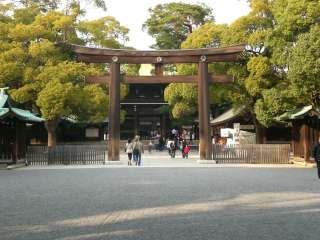 Even with a short stay of three frigid days (relative to Bangkok, at any rate), we packed in the temple visits. There was a climb through the red tunnel of shrine gates and up the steps to Hie-Jinja shrine and a stop at the exquisite Meiji-jingu Shinto shrine, which was arguably the prettiest temple/church/mosque/shrine we’ve seen on this RTW trip. Despite the crowds there on that Saturday afternoon, it maintained a remarkably peaceful atmosphere.
Even with a short stay of three frigid days (relative to Bangkok, at any rate), we packed in the temple visits. There was a climb through the red tunnel of shrine gates and up the steps to Hie-Jinja shrine and a stop at the exquisite Meiji-jingu Shinto shrine, which was arguably the prettiest temple/church/mosque/shrine we’ve seen on this RTW trip. Despite the crowds there on that Saturday afternoon, it maintained a remarkably peaceful atmosphere.
Located a short distance from this Shinto shrine, was a personal temple for us: a Tokyo branch of Muji. As we approached, Marc said, with a silly grin, “I feel like I’m nearing Mecca.” Ever since we visited our first Muji in Seoul, we have been on the lookout for branches of this Japanese home-decor/clothing/lifestyle store in each city we visit. 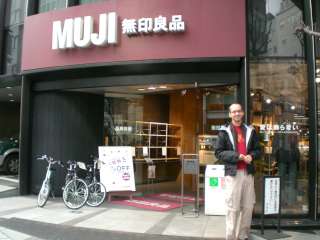 So far, we’ve only been lucky enough to see two others: one in Paris and one in Bangkok, and each spotting is accompanied with a sharp intakes of breath and much excited hand-fluttering. Therefore, we couldn’t miss the opportunity to see a branch in Tokyo, the heart of it all, the place where design and form match function and style and then go on sale. Maybe our hopes were pinned a little high – just maybe – because this Muji fell kind of short of our expectations. Though that didn’t stop us from combing the store and dreaming of the apartment we’ll one day have and Mujify.
So far, we’ve only been lucky enough to see two others: one in Paris and one in Bangkok, and each spotting is accompanied with a sharp intakes of breath and much excited hand-fluttering. Therefore, we couldn’t miss the opportunity to see a branch in Tokyo, the heart of it all, the place where design and form match function and style and then go on sale. Maybe our hopes were pinned a little high – just maybe – because this Muji fell kind of short of our expectations. Though that didn’t stop us from combing the store and dreaming of the apartment we’ll one day have and Mujify.

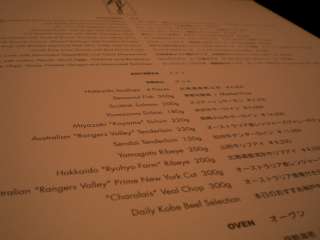 According to the menus, those were just appetizers but even in our alcohol infused state, we could not justify spending $80 for a rib eye steak or – perish the thought – $190 for the Kobe beef steak. We did have one more glass of wine, though. In total, for two people, two drinks each, two appetizers: $200CAD. Obscene, opulent, delicious, exquisite. Unrepeatable.
According to the menus, those were just appetizers but even in our alcohol infused state, we could not justify spending $80 for a rib eye steak or – perish the thought – $190 for the Kobe beef steak. We did have one more glass of wine, though. In total, for two people, two drinks each, two appetizers: $200CAD. Obscene, opulent, delicious, exquisite. Unrepeatable. Rising at dawn, we visited the Tsukiji Fish Market for the height of the morning rush. After navigating our way through the trucks, vans and motorized trolleys, we found the main fresh fish market with hundreds of vendors selling fish whole, filleted or still alive. Men ran frozen tuna through enormous band saws while others filleted eel after eel or sliced off chunks of fish with a knife three feet long, any of these jobs requiring rubber boats, plastic pants and a wet suit like jacket to keep warm and dry.
Rising at dawn, we visited the Tsukiji Fish Market for the height of the morning rush. After navigating our way through the trucks, vans and motorized trolleys, we found the main fresh fish market with hundreds of vendors selling fish whole, filleted or still alive. Men ran frozen tuna through enormous band saws while others filleted eel after eel or sliced off chunks of fish with a knife three feet long, any of these jobs requiring rubber boats, plastic pants and a wet suit like jacket to keep warm and dry.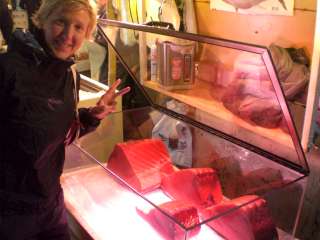 Some of the tourists wore plastic bags on their shoes, but that is dangerous on slippery concrete floors running with water and blood. With fish and guts everywhere, I was surprised by the complete lack of smell. Perhaps it’s different in the summer, but on our visit everything was surprisingly fresh.
Some of the tourists wore plastic bags on their shoes, but that is dangerous on slippery concrete floors running with water and blood. With fish and guts everywhere, I was surprised by the complete lack of smell. Perhaps it’s different in the summer, but on our visit everything was surprisingly fresh.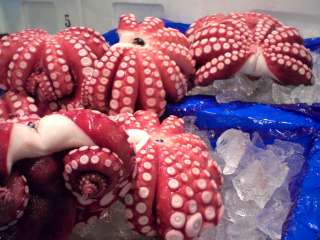 It was hard not to consider the enormity of it all—a vast industry cleaning the ocean of edible life. At no point could we see the entire market and this was only one market in one city. Live sea cucumber to whale bacon, all prepared or packaged to feed our enormous population.
It was hard not to consider the enormity of it all—a vast industry cleaning the ocean of edible life. At no point could we see the entire market and this was only one market in one city. Live sea cucumber to whale bacon, all prepared or packaged to feed our enormous population.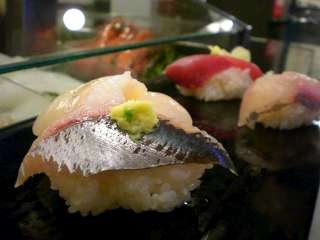 Those contemplations didn’t stop us from enjoying a sushi breakfast at one of the many restaurants that fringe the market. In Tokyo, few people speak English, but most people are used to dealing with people who don’t speak Japanese. In this case we were directed to the wall menu for a choice of the $20 set or the $30 set and an Engligh drink menu was provided. As the sushi chef completed a serving, he dropped it in front of us on a black laquered board that ran around the bar, which was used instead of a plate. Wow, so fresh. Most were the usual suspects, tuna and shrimp, but one animal we only reconginized from the fish market—a sort of dark flattened shrimp. It tasted much stronger than a shrimp, not something I’ll likely seek again.
Those contemplations didn’t stop us from enjoying a sushi breakfast at one of the many restaurants that fringe the market. In Tokyo, few people speak English, but most people are used to dealing with people who don’t speak Japanese. In this case we were directed to the wall menu for a choice of the $20 set or the $30 set and an Engligh drink menu was provided. As the sushi chef completed a serving, he dropped it in front of us on a black laquered board that ran around the bar, which was used instead of a plate. Wow, so fresh. Most were the usual suspects, tuna and shrimp, but one animal we only reconginized from the fish market—a sort of dark flattened shrimp. It tasted much stronger than a shrimp, not something I’ll likely seek again.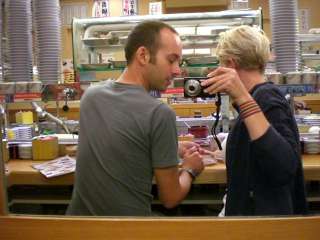 Just before we left Bangkok, we used up our last remaining bhat on a spicy green mango salad that was so spicy that I could see through time. We stopped in Seoul the next morning on a layover that was long enough to eat bibimbap with kimchi for breakfast, something we’ve been craving for months. Finally, we arrived in Japan and had a late lunch of a lot of sushi. I doubt we’ll be able to come close to replicating that phenomenon in the future, unless we have maple syrup in the morning and cross the border for American cheese in the afternoon. Doesn’t seem as exotic, though.
Just before we left Bangkok, we used up our last remaining bhat on a spicy green mango salad that was so spicy that I could see through time. We stopped in Seoul the next morning on a layover that was long enough to eat bibimbap with kimchi for breakfast, something we’ve been craving for months. Finally, we arrived in Japan and had a late lunch of a lot of sushi. I doubt we’ll be able to come close to replicating that phenomenon in the future, unless we have maple syrup in the morning and cross the border for American cheese in the afternoon. Doesn’t seem as exotic, though.